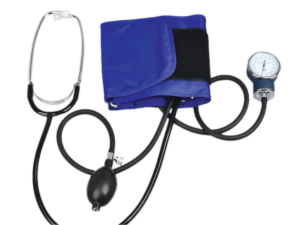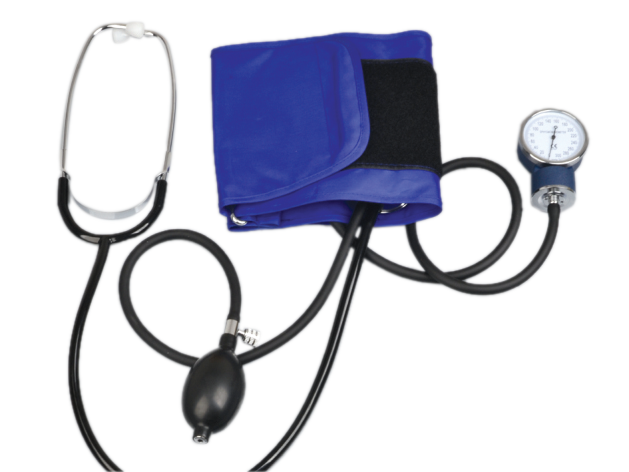Aneroid Sphygmomanometer (with attached single head stethoscope)
Aneroid Sphygmomanometer (with attached single head stethoscope)
Monitoring your blood pressure at home is an essential part of managing your health, and having the right equipment can make all the difference. In this article, we’ll be looking at the advantages of using an aneroid sphygmomanometer with attached single head stethoscope as a blood pressure monitor. Read on to find out why this is a great choice for monitoring your blood pressure!
Description
Blue gauge, round shape nylon cuff with D-ring, latex bulb, latex inflation system, stop-pin.
How to Get a Good Measurement Using an Aneroid Sphygmomanometer
If you're looking for an accurate and reliable blood pressure monitor, an aneroid sphygmomanometer is a great option. Here's how to get a good measurement using one:
1. Place the cuff around your upper arm, making sure that the bottom edge is level with your heart.
2. Pump the cuff up until it's snug but not too tight - you should be able to fit two fingers underneath it.
3. Use the stethoscope to listen for your pulse in your brachial artery (located in your upper arm).
4. Slowly release the air from the cuff while continuing to listen for your pulse.
5. When you can no longer hear your pulse, note down the reading on the gauge - this is your systolic blood pressure.
6. Continue releasing the air until the cuff is completely deflated.
What is an Aneroid Sphygmomanometer?
An aneroid sphygmomanometer is a device that is used to measure blood pressure. It consists of a cuff that is placed around the upper arm and a mercury or aneroid manometer that is used to measure the pressure. The cuff is inflated with air and then the mercury or aneroid manometer is used to measure the pressure. The reading on the mercury or aneroid manometer will give the systolic blood pressure, which is the top number, and the diastolic blood pressure, which is the bottom number.
Is the Single Head Stethoscope Attached to the Sphygmomanometer?
If you're looking for an easy-to-use blood pressure monitor that comes with a single head stethoscope attached, then the aneroid sphygmomanometer is a great option. This type of blood pressure monitor is simple to use and can be easily attached to your clothing. The single head stethoscope helps to ensure accuracy when taking readings.
Speaking of Blood Pressure Monitors...
If you're looking for a blood pressure monitor that is both accurate and easy to use, the Aneroid Sphygmomanometer with Attached Single Head Stethoscope is a great option. This blood pressure monitor has a large, easy-to-read dial and comes with a stethoscope attached, so you can take your own blood pressure readings at home. The Aneroid Sphygmomanometer with Attached Single Head Stethoscope is a reliable and affordable way to keep track of your blood pressure. This blood pressure monitor is simple to use and comes with clear instructions. It's also lightweight and portable, so you can take it with you when you travel.
Aneroid Sphygmomanometer With Single life has made colorful health pitfalls similar as hypertension, heart complaint, and other common cardiovascular conditions decreasingly common. Picking the right sphygmomanometer is a smart choice that we should all consider daily, for the good of our healthy bodies.
The first blood pressure dimension was recorded in the time 1733, and the first sphygmomanometer was constructed in the time 1881 by Samuel Siegfried Karl Ritter von Basch. The introducing design comported of two corridor – a rubber bulb filled with water, and a mercury column. The water in the rubber bulb was used to circumscribe the blood inflow in the roadway, while the mercury column was connected to the bulb that restated the pressure needed to obscure the palpitation into millimeters of mercury fully. In 1896, Scipione Riva-Rocci made farther advancements in Ritter’s first sphygmomanometer. He added a cuff that could be fixed around the arm to apply pressure on the branch, to measure the blood pressure. This design came the standard for similar bias latterly on.
Aneroid Sphygmomanometer With Single
In 1905,Dr. Nikolai Korotkoff discovered the difference between systolic blood pressure and diastolic blood pressure. This discovery laid the foundation for ultramodern blood pressure dimension as we know it moment. Simply put, when pressure is applied and released, they're accompanied by the appearance or exposure of sounds within the highways. These systolic and diastolic sounds are therefore used as norms in blood pressure dimension and are known as Korotkoff sounds. The sphygmomanometer outfit has since also evolved greatly to the available technology offered moment, now more generally known as the BP outfit.
Types of Aneroid Sphygmomanometer With Single
Advancements in the sphygmomanometer, or blood pressure needles as they're also frequently called, have been relatively emotional over the times. Medical bias have come more technical, and colorful types of sphygmomanometers have come available in the request. Outlined in our list below are three major types of sphygmomanometers – mercury, aneroid, and digital.
Mercury Aneroid Sphygmomanometer With Single
The mercury sphygmomanometer is the most conventional form of blood pressure outfit, and it can be considered the golden standard in the health assiduity. Mercury sphygmomanometers are made up of manually inflatable bond that are attached to measuring units with mercury- invested tubes. While operating the device, it's important to place the outfit on a flat face and in an upright position to get the correct readings. These bias are veritably delicate and bear special care, and if accidentally dropped can beget a rupture of mercury, rendering the device useless and potentially dangerous.
The biggest advantage of using mercury sphygmomanometers is that they're relatively easy to use, and if used duly, can last a continuance. The device can produce the most accurate results without taking important adjustment. Due to the poisonous nature of its contents, still, the use of mercury sphygmomanometers has been banned in some countries, and other forms of sphygmomanometers are being used rather.
Aneroid Sphygmomanometer
Aneroid means “ without fluid,” and as the name suggests, this type of BP outfit does n’t make use of any mercury and is thus considered the safest volition to mercury sphygmomanometers. Its recording procedures are enough analogous to that of the mercury sphygmomanometer, except the stethoscope’s attachment to the cuff. In the android device, the cuff is attached to a dial hand with tubing. The hand head contains mechanical corridor that convert the cuff pressure into hand- grounded reading. Also, there are colorful other types of aneroid sphygmomanometers depending on how they're used. These include fund-aneroid sphygmomanometers, win aneroid sphygmomanometers, and timepiece- style aneroid sphygmomanometers. Eventually, the benefit of using aneroid sphygmomanometers is the affordability of the outfit, as well as its compact and handy nature. Still, analogous to other bias used to measure blood pressure, aneroid sphygmomanometers make use of a delicate medium and thus necessitates careful running. Aneroid sphygmomanometers also bear recalibration by experts, to avoid cases of defective reading.
Automatic Aneroid sphygmomanometer online
The automatic digital sphygmomanometer is the most technologically-advanced sphygmomanometer design to date. These bias use an electronic pressure detector to measure blood pressure, and the readings are presented on a digital display. Analogous to mercury and aneroid sphygmomanometers, digital sphygmomanometers also come with inflatable bond, but there's a difference in the procedure for measuring blood pressure. Unlike the other two types, automatic digital sphygmomanometers estimate and measure the oscillations of highways. These bias are perfect for home use as they're the easiest to operate. To avoid the threat of inaccurate readings, periodic counter checks with conventional mercury sphygmomanometers are recommended.

How to Use Aneroid Sphygmomanometer with attached
In making use of sphygmomanometers, procedures vary according to the type and variety of sphygmomanometer used, but all kinds operate on a single principle. A bulb increases the pressure by inflating the cuff placed around one’s arm, and a stopcock releases the pressure. During this process, a stethoscope is used to hear to arterial blood inflow sounds. As the jiffs, blood going through the highways causes a rise in pressure, which snappily decreases when the heart’s ventricles prepare for another beat. This rise and fall are called systolic and diastolic pressure, independently. Below are the way to directly measure one’s blood pressure.
Know your introductory knowledge of blood pressure readings. Blood pressure readings are expressed as systolic over diastolic pressure. The normal blood pressure of an average healthy grown-up is120/80.
Use proper-sized bond. Cuffs that are too loose or too tight may impact the delicacy of blood pressure measures. The cuff should be 80 of the circumference of the upper arm. Be sure not to place the cuff on a clothed arm.
Duly place the cuff on the arm. While belting the cuff around the upper arm, keep the lower edge of the cuff one inch above the antecubital fossa, the region of the arm in front of the elbow.
Position the stethoscope. Smoothly press the stethoscope bell over the brachial roadway, just below the lower edge of the cuff.
Inflate the cuff. Using the bulb, inflate the cuff to 180 mmHg, also release using the stopcock at a moderate rate of about 3 mm per second.
Hear and observe. While examining the dial or mercury hand, hear for a knocking sound with the stethoscope. The first knocking sound represents the systolic blood pressure of the case. The point when the sound disappears meanwhile signifies the diastolic pressure.
Repeat the procedure on the other arm. For accurate analysis, it's recommended that the blood pressure of both arms be measured. The difference in dimension of both arms, as well as the case’s
position and cuff size, must be noted.
